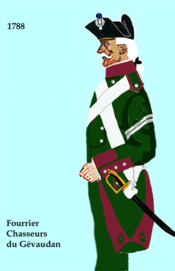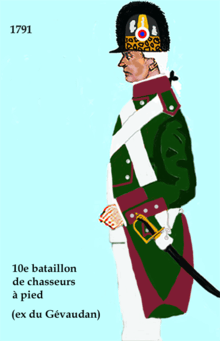Chasseurs du Gèvaudan
The Chasseurs du Gèvaudan was a light infantry battalion of the French Royal Army which was created just before the French Revolution. The battalion would see service during the initial stages of the conflict, but the lineage ended after being amalgamated with two volunteer battalions to form a demi-brigade. The battalion's successor, the 85éme Régiment d'Infanterie continued to serve in the modern French Army until 1940 when it was disbanded following the Battle of France.
| Chasseurs du Gèvaudan 10éme Bataillon de Chassers (Gèvaudan) | |
|---|---|
 Regimental uniform after formation in 1788. | |
| Active | 1788–1795 |
| Country | |
| Allegiance | King of France French Nation |
| Branch | |
| Type | Chasseurs à Pied |
| Size | Battalion |
| Part of | Army of the North Army of General de Dampierre |
| Headquarters | Bitche |
Formation
The Chasseurs du Gèvaudan was formed in and was to recruit exclusively from troops of the Gévaudan region of Languedoc. The new battalion was organised from the infantry companies of the Chasseurs à Cheval du Gèvaudan, and grouped Berghes, where it established its headquarters. The battalion was placed 10th in precedence of the chassuers, after the Chasseurs des Cévennes and before the Chasseurs des Ardennes.[1][2]
The regiment's first uniform consisted of; black tricone (officers in bicorne), crimson collar, dark green turnbacks, dark green jacket, dark green breeches, dark green gaiters, black boots, dark green pockets, dark green pockets, crimson cuff flaps, crimson cuffs, and white buttons.[1][3][4]

In late 1788 the battalion moved to Landrecies and Bouchain before moving to Maubeuge in early 1791.[2]
Revolution
On 1 April 1791, provisional regulations were announced following the initial stages of the French Revolution, and the regiment renamed as the 10éme Bataillon de Chasseurs (Cévennes), but they continued to be known as their former title until 1792. In addition to the new title, the regiment adopted a new uniform; peak casque, with stiff black horsehair crest and mock leopard skin turban helmet, crimson collar, dark green turnbacks, dark green jacket, dark green breeches, dark green gaiters, black boots, dark green pockets, dark green pockets, crimson cuff flaps, crimson cuffs, and white buttons.[1][3][4]
War of the First Coalition
In 1792 the battalion joined the vanguard of the Army of the North Armée du Nord and contributed to the Flanders campaign. After the campaign, the battalion returned to Valenciennes, and after the Battle of Neerwinden it joined the forefront of the Army of General de Dampierre.[2]
In early April 1793, the battalion allowed itself (somehow) to be surprised by the Austrians and the majority of the battalion captured or slaughtered. In October, under general Jean-Baptiste Jourdan, the battalion marched to the aide of Maubeuge where it stood out extremely well in the battalions fought around the centre of the château (castle).[2]
On 7 October 1793, the battalion captured the Redoubt of the Wolf Redoute du Loup from the Hungarians, where panic and terror seized a battalion of volunteers of the Eure and fled. The chasseurs, indignant, took off the tie from the flag of the cowards, and remained on the redoubt until that evening.[2]
The years following the Revolution saw great changes for the French Army: the old royalist infantry regiments were to serve as the stiffening for the tens of thousands of new volunteers who answered the patriotic Levée en masse. In the First Amalgamation of 1794, each old royalist battalion was put together with two new volunteers battalions to become new Demi-Brigade de Bataille or Demi-Brigade of Battle. Therefore, on 24 February 1795, the battalion amalgamated with the 16th Battalion of Chasseurs (Légion du Centre) and 1st Battalion of the Legion of the Moselle to form the 10éme Demi-Brigade Légère, thus ending the royalist lineage and traditions.[1][2]
Commanding Officers
Commanding officers of the battalion were:[2]
- 1788–1789 Antoine Benolt de La Vergne
- 1789–1791 Jean Joseph Christophe de Bazelaire
- 1791–1792 Charles Alexandre Hilaire Guyon de Quigny
- 1792–1795 Charles Marie Le Pescheux
Footnotes
- Susane, Volume I, pp. 311, 313–314, 364, 369, 399, 404.
- Susane, Volume VII, pp. 387–388.
- Lienhart & Humbet, pp. 57–58.
- Smith, Uniforms of the Napoleonic Wars, p. 42–47.
References
- Louis Susane, Historie de l'Ancienne Infanterie Français, Volume I, 1849 Naval and Polytechnical Military Library of Paris, Paris, France.
- Louis Susane, Historie de l'Ancienne Infanterie Français, Volume VII, 1853 Naval and Polytechnical Military Library of Paris, Paris, France.
- Dr. Constance Lienhart & Réne Humbert, The Uniforms of French Armies 1690–1894; Volume 3: The Infantry, Originally published in 1906, re-printed in 2020, Zanica, Italy. ISBN 978-8893275255.
- Digby Smith & Jeremy Black, An Illustrated Encyclopedia of Uniforms of the Napoleonic Wars, 2015 Lorenz Books, London, United Kingdom. ISBN 978-0-7548-1571-6.